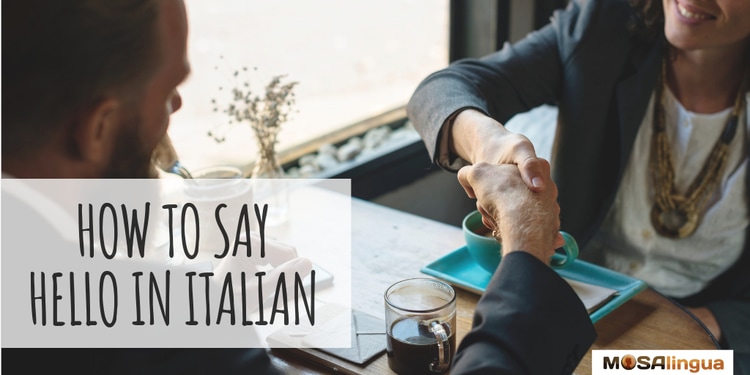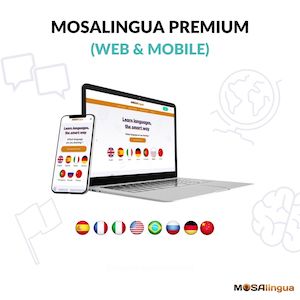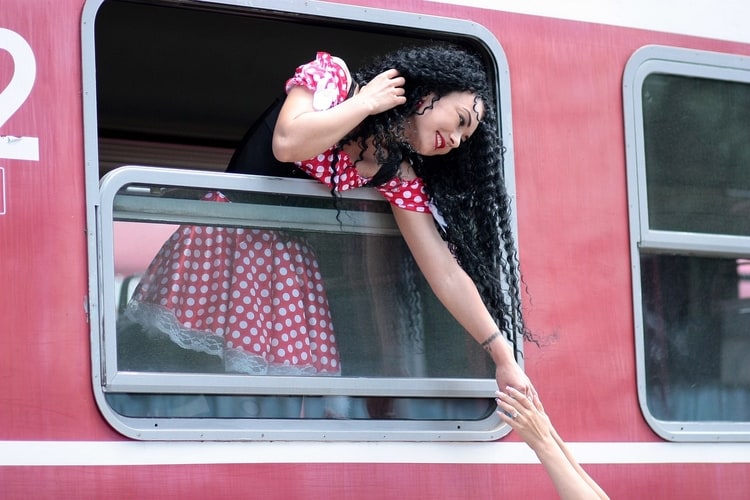Ciao, bella! Like any language, learning how to say hello in Italian is a great place to start. Italians are known for being friendly and having a welcoming attitude, but the way you choose to say hello can make or break a budding friendship or business partnership. So, we’ve brought together some tips for getting it right every time!

Saying Hello in Italian: Getting It Right
Easy Ways to Say Hello in Italian
Ciao!
Ciao is the buzzword everyone knows. You’ve probably heard it everywhere, especially in Italian movies. It’s simple, easy to pronounce, and even doubles up as hello and goodbye. So you might be tempted to use it as a go-to way to say hello in Italian. But it’s also one you need to be careful with. Ciao is actually a very informal way to say hello in Italian. A native Italian might use it amongst friends, but wouldn’t use it in a formal setting.
This depends on where you are in Italy though. As you might already know, dialects across Italy are very different from each other. The way each region looks at this phrase is very different! The word originates in the Venetian dialect of Italian, from the phrase Scia’o vostro (“I am your slave”). That’s right! Scia’o comes from the Italian word for slave, schiavo. When it’s used in vèneto, the general meaning is “I’m here if you need anything!” So you can see how this connects to being someone’s slave, even if the link is a little dark!
In everyday conversation, it’s best to use this greeting with people you’re close to. It doesn’t exactly count as slang, but if you’re talking to a stranger, or in a polite or formal setting, it’s best to avoid it! There are much better ways to say hello in Italian if you’re not close to someone.
Salve!
Salve is a good choice if you don’t know whether you should use a formal or informal way to say hello. It can be used in polite situations as well as informal ones, so you don’t have as much to worry about with this one. If we’re being strict, it does come across a little more on the formal side, but it’s generally a good alternative to Ciao.
Start learning a new language today

Good news: we can help!
More good news: you can get started for free! Start your free trial now and for the next 15 days, take advantage of the most effective language learning method on the market!
Vocabulary flashcards, videos with subtitles, audiobooks, articles adapted to your level – with MosaLingua Premium (Web & Mobile), you’ll have access to all this and more. Get started right now. It’s free—and risk-free—to try!
Don’t Forget Anyone! 👨👩👦👦
If you’re saying hello to a group, don’t hesitate to say hello to everyone at the same time. This is pretty easy to do if you’re in an informal setting. Just add “a tutti” to either of the phrases above.
- Ciao a tutti – like Ciao, you’d use this for friends and people you are close to in an informal setting.
- Salve a tutti – the same as Salve, this phrase is great for groups of people in a more formal setting, or when you’re not sure of the formality yet.
Italian Greetings for Certain Times of Day
- Buongiorno
Buongiorno literally means “good day.” It’s pretty similar to “bonjour” in French or “Guten Tag” in German. This is a simple and relatively popular way to say hello in Italian. That said, it’s a little more formal than ciao, so it’s also useful if you don’t know where you stand with the person you’re greeting. Once someone replies Ciao to your Buongiorno, feel free to make the switch. - Buon pomeriggio
This one is for when it’s getting a little later in the day. Buon pomeriggio translates to “good afternoon,” so it’s a good one to use once the morning has passed and Buongiorno doesn’t quite fit anymore. - Buonasera
Buonasera is your standard way to say “good evening” in Italian. This is the perfect way to say hello in Italian if you’re out of work for the day and meeting your friends for an aperitivo (or even a festa!). - Buonanotte
Buonanotte means “goodnight” in Italian. Like Buongiorno, this one is a little more on the formal side, but can still be used among friends and acquaintances. That means it’s also a good way to go if you’re not sure about the formality you need. Buonanotte also doubles up as a way to wish someone a good night in Italian, so it’s a good term to have under your belt!
Now you’ve got a few options ready for when you need to say hello in Italian, you can confidently start a conversation. But remember, even if you have them at hello, that won’t be the end! You’ll probably need to have a few more phrases ready for when someone responds.
Keep the conversation going: Beyond “hello” in Italian
If you’re planning on having a conversation, you might want to brush up on some useful Italian phrases. For now, here are some easy ways to carry on a conversation after you’ve said hello in Italian:
- Come va? – How’s it going?
This is a great way to carry on after you’ve said hello. Ask someone how things are, and open up the conversation for discussion. - Come stai? – How are you?
Like come va, this phrase opens up the conversation for different topics. - Come sta? – Also means “How are you?” in Italian formal speech; use this for people who are older than you or generally to show respect (to your boss or doctor, for instance).
If someone asks you these questions, here are a couple of ways you could respond:
- Molto bene, grazie – Very well, thanks!
- Sto bene grazie, e tu? – I’m well, thanks! And you?
- Così così – So-so (not too bad).
How to Say Goodbye in Italian
Finally, if you’re going to open a conversation by saying hello in Italian, you might want to know how to close one! Here are a few friendly ways to say goodbye in Italian.
- Arrivederci
Arrivederci is similar to Ciao. You can use it to say goodbye to people you are familiar with in an informal setting. It can also be used in formal settings, but sparingly. - Arrivederla
You can use Arrivederla instead of Arrivederci when you’re in a more formal setting, or want to be more polite. - A dopo – See you later
This translates literally to “until later,” but you don’t necessarily have to be seeing that person later to use it. - A fra poco – See you in a bit!
This phrase is generally only used if you know you’ll see that person shortly. Similar to English, you’d only use it if you are sure you’re going to see that person later in the day. - A domani – See you tomorrow
A domani does as it says on the tin! You can also replace “domani” with a day of the week, such as a lunedi (“See you Monday”) - A presto – See you soon
Like A dopo, this phrase can be used when you’re not sure of the next time you’ll see the person you’re speaking to, but you think it will be soon.
We’ve talked about formal and informal settings, but you might also hear something different when you’re around kids. Ciao-ciao is often used by children to say hello or goodbye in Italian. Like “bye-bye” in English, it’s a cuter way to say “bye.”
Conversation Tips
You’re all set! Now that you can confidently say hello in Italian, you’re on your way to sailing through conversations with natives. For some more tips on how to speak Italian with confidence, check out Mara’s useful video on which verbs can boost your confidence with spoken Italian!
Don’t forget to subscribe to our YouTube channel for more handy videos, follow us on Instagram and check out our Facebook page for tips and tricks on learning Italian. A presto!



![How to Pronounce the th /ð/ Sound | American English Pronunciation [VIDEO]](https://www.mosalingua.com/en/files/2017/03/Copy-of-MASTER-YouTube-Thumbnail-template-300x169.jpg)


Comments